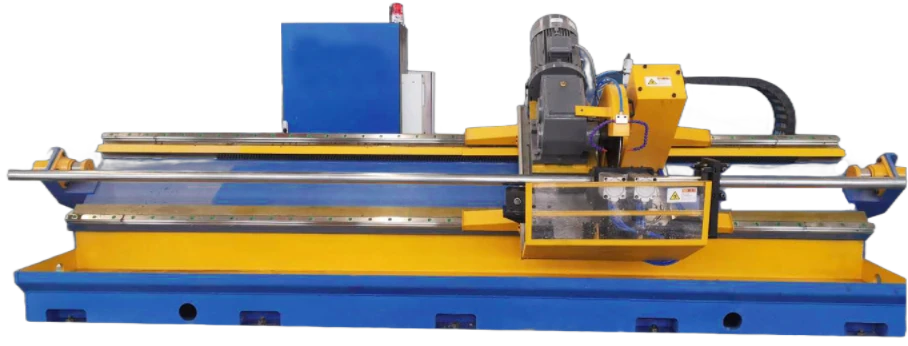Innovative Design Concepts for Decoiler Machines in Modern Manufacturing Processes
Decoiler Machine Design An Essential Component in Metal Fabrication
In the realm of metal fabrication, the decoiler machine plays a critical role in efficiently processing metal coils. As industries increasingly demand precision and speed in manufacturing, the design and functionality of decoiler machines become paramount. This article delves into the essential aspects of decoiler machine design, focusing on its components, operational principles, and modern advancements.
What is a Decoiler Machine?
A decoiler machine, also known as a coil unwinder, is designed to unwind and feed metal coils into production lines. These machines are crucial for operations that utilize rolled metal sheets, such as in the automotive, construction, and appliance industries. By converting heavy coils into manageable sheets, decoilers streamline the manufacturing process, enhancing productivity and reducing downtimes.
Key Components of Decoiler Machines
1. Frame and Structure The frame of a decoiler must be robust to support the weight of hefty metal coils, typically ranging from a few hundred kilograms to several tons. Sturdy materials, often steel, are utilized to ensure durability and stability during operation.
2. Payoff Arm This component allows the coil to rotate freely as it unwinds. The payoff arm is adjustable to accommodate different coil sizes, ensuring that the decoiler can handle various dimensions and weights.
3. Mandrel The mandrel is a cylindrical mechanism around which the coil is mounted. It can be powered or passive, depending on the design. A powered mandrel utilizes a motor to assist in unwinding the coil, whereas a passive mandrel relies on gravity or manual effort.
4. Braking System An effective braking system is vital to control the unwinding speed of the coil, preventing it from unwinding too rapidly, which could lead to product defects or machine damage. This system may include pneumatic or mechanical brakes.
5. Guide Rollers These rollers help maintain the alignment of the metal sheet as it unwinds, preventing distortion and ensuring a smooth feed into the subsequent processing stage.
6. Control System Modern decoiler machines come equipped with advanced control systems that enable operators to adjust parameters such as tension, speed, and direction. These systems enhance operational efficiency and support automation.
decoiler machine design

Operational Principles
The operation of a decoiler machine involves several steps. Initially, a coil is mounted onto the mandrel, and the system is calibrated to the specific coil dimensions. As the decoiler is activated, the coil unwinds, facilitated by the payoff arm. The braking system regulates the unwinding speed, and the guide rollers ensure that the metal sheet travels smoothly to the next stage of production.
The design must also take into account the ease of loading and unloading coils. Quick-change systems are often integrated, allowing operators to replace coils rapidly, thus minimizing downtime and increasing overall productivity.
Modern Advancements in Decoiler Design
With advancements in technology, modern decoiler machines have implemented several innovative features
- Automation Many decoilers now incorporate automated systems that allow for more precise control over the unwinding process. This automation can significantly reduce labor costs and enhance safety on the shop floor.
- IoT Integration The Internet of Things (IoT) has opened new avenues for decoiler design, enabling real-time monitoring and diagnostics. This feature helps in predictive maintenance, reducing the risk of unexpected breakdowns.
- Energy Efficiency New designs focus on reducing energy consumption, incorporating energy-efficient motors and regenerative braking systems that save power during operations.
Conclusion
In summary, the design of decoiler machines is a vital aspect of the metal fabrication industry, contributing to efficiency and productivity. With robust construction, advanced components, and modern technological advancements, decoiler machines continue to evolve, meeting the growing demands of various manufacturing sectors. As industries progress, the significance of effective decoiler machine design remains paramount in ensuring seamless production flows and maintaining high-quality standards in metal processing.
-
High Frequency Straight Seam Welded Pipe Production Line-BzZhou Xinghua Machinery Equipment Manufacturing Co., LTD.|Precision Welding, High EfficiencyNewsJul.30,2025
-
High Frequency Straight Seam Welded Pipe Production Line|BzZhou Xinghua|Precision Welding&EfficiencyNewsJul.30,2025
-
High Frequency Straight Seam Welded Pipe Production Line - BzZhou Xinghua|Precision Engineering&EfficiencyNewsJul.30,2025
-
High-Frequency Straight Seam Welded Pipe Production Line-BzZhou Xinghua Machinery Equipment Manufacturing Co., LTD.NewsJul.30,2025
-
High-Frequency Straight Seam Welded Pipe Production Line-BzZhou Xinghua Machinery Equipment Manufacturing Co., LTD.|Precision Manufacturing, High EfficiencyNewsJul.30,2025
-
High Frequency Straight Seam Welded Pipe Production Line-BzZhou Xinghua Machinery Equipment Manufacturing Co., LTD.|Precision Steel Pipe Manufacturing&Industrial EfficiencyNewsJul.29,2025


